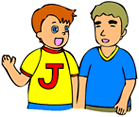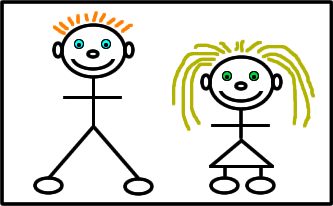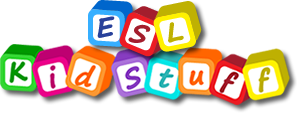Download a new song from ESL KidStuff: Describe Your Friend (Adjectives)
 Describe Your Friend (Adjectives)
Describe Your Friend (Adjectives)
Song Theme: Using adjectives to describe the physical appearance of people
Target Vocab: What does s/he look like?, Tell me all about him/her, s/he is/has …, tall, short, long hair, short hair, brown eyes, blue eyes, blonde hair, black hair, s/he is great.
Song Length: 1:01
A lively song about describing your best friend which includes descriptive adjectives and 3rd person he / she.
(Members can log in to download the full song)
Lyrics:
Tell me about your best friend!
Chorus:
What does he look like?
What does he look like?
Tell me all about him.
Verse 1:
He is tall
He has short hair
He has brown eyes
He has blonde hair
But most of all, he is great!
Tell me about your best friend!
Chorus:
What does she look like?
What does she look like?
Tell me all about her.
Verse 2:
She is short
She has long hair
She has blue eyes
She has black hair
But most of all, she is great!
Gestures and activities to use with the “Describe Your Friend (Adjectives)” song
There are no gestures for this song – a listening activity with worksheets accompanies the song (see point 3 below). However, if students enjoy the song you can encourage them to sing along and dance!
Here are the worksheets: Describe Your Friend song worksheets
- The first two pages is the song poster.
- The next page “Describe your Friend Worksheet 1” is a ‘listen and circle what you hear’ exercise.
- The final page “Describe your Friend Worksheet 2” is a ‘listen and draw’ exercise (this is better if you can’t print out the color Worksheet 1)
Using the “Describe Your Friend (Adjectives)” song in class
This is a really lively song which can be used as an active listening task – students have to listen to the song to complete their worksheets.
- Introduce the descriptions vocab. For this lesson you are going to use your artistic drawing skills. Use a whiteboard or blackboard to draw the following:
- At the top of the board draw 2 circles (these will be the heads). Elicit “circles”.
- On each head draw a nose, ears and a mouth. Elicit each as you draw them. Then ask “What’s missing?”.
- Elicit “eyes”. Ask “What color are they?” and give the students the options of the colors of markers / chalk you have. Then draw the eyes in the chosen colors with different colors for each set of eyes (NB: it’s ok to have strange colors, such as yellow, for the eyes – this will just make it more fun).
- Elicit “hair” and again ask “What color is it?”. On one head draw long hair in one color (for the girl) and on the other draw short hair (for the boy) in a different color. Teach / Elicit “long / short hair”.
- Finally, you’ll need to draw 2 bodies. But rather than you draw them you are going to ask for 2 volunteers to do the drawings. For the girl, draw some shoes quite near the head (so that she will be short) and for the boy draw some shoes right down at the bottom of the board (so he will be tall). Have the students draw the bodies so that they join the heads with the shoes. Now teach / elicit “tall / short”.
It should end up looking something like this:

- Now that the completed pictures are on the board, chorus 3 times the following sentences and point to the pictures as you do:
– He is tall.
– He has short hair.
– He has (blue) eyes.
– He has (orange) hair.– She is short.
– She has long hair.
– She has (green) eyes.
– She has (brown) hair.
- Do “Funny Body” drawings. Give a piece of A4 paper to each student and yourself.
- On your piece of paper, model drawing a head with eyes, nose, ears, mouth, teeth and hair. Make it a really funny picture. Then tell everyone to draw their funny head. Make sure they use colors for the eyes and hair.
- Next show them how to fold the paper so only the neck shows (so the head is folded behind). Then get everyone to pass their paper to a different student.
- Now model drawing the body starting from the neck and going down to ankles – make it either a really short or long body and make it as funny as you can. Now have your students draw their bodies.
- Again, show everyone how to fold the paper so only the ankles are showing and have everyone pass their paper to another student.
- Finally, model drawing funny feet and get everyone to draw feet on their pictures. Then get everyone to fold up their papers and return each piece to the person who drew the head.
- Let everyone open up their paper and have a good laugh at the pictures. Now ask everyone to “present” their person in the drawing to the rest of the class – you model first (e.g. “This is Tom. He is short. He has pink hair, etc.”).
- Play the “Describe Your Friend” song and do the active listening worksheet. Tell the class that they are going to listen to a song about a boy and a girl. Give out either “Describe your Friend Worksheet 1” or “Describe your Friend Worksheet 2” (worksheet 2 is better if you cannot print out colored worksheets). Read the instructions to the class and then play the song. As they song is playing students should do the worksheet activity. Play the song again if required. Finally, go through the song one more time stopping to check answers. If everyone enjoyed the song, you can play it again and have everyone sing along (especially as it’s such a catchy tune!).
- Do the “Describe Your Friend Class Survey“. This will give your students the chance to use the lesson structures. Give out the class survey worksheet. Each student should work on their own for a few minutes looking at their classmates and filling in the table about 6 of their friends in the class. Whilst they are doing this, circulate and check and ask questions. Finally, once everyone has finished, ask each student to describe some of their friends: Ask, “Tell me about your friend”, “What does he / she look like?”. Then put students in pairs to practice asking about their classmates.
Additional activity: Have your students ask about and describe family members (e.g. brothers, sisters, parents, grandparents, etc.).
- Play “Guess Who?”. For this activity, you’ll need lots of magazine pictures of people. Try and get lots of different types of people pictures, with different color eyes and hair. The more pictures you can find and cut-out before class the better (Note: This is a great resource to have for future lessons, as people pictures can be used in many different ways). In class, lay out all of pictures on the floor or on a large table. Start by saying “My friend has (short, brown) hair, he is (tall) and he has (green) eyes”. Everyone should try and guess which picture you are describing. You can also give additional clues (clothes, etc.). The student who guesses correctly can then have a go describing someone. Now that everyone has got the idea of the game, put student into small groups and have them play the game together. Whilst they are playing, monitor, help and encourage the use of the lesson structures.
- Set Homework: For homework, give out the “Describe Your Family” worksheet.
Related Stuff:
- Download all songs
- The Hello Song and The Goodbye Song
- The Numbers Song
- The ABC Song
- Head, Shoulders, Knees & Toes
- The Rainbow Song
- Old MacDonald
- What Can You Do?
- The Feelings Song
- The Days of the Week Song
- Months March song
- How Did You Get Here Today?
- Mr. Shape Head
- Let’s Go to the Zoo
- What Fruit do you Like?
- Where are my Things?
- The Morning Routines Song
- If You’re Happy and You Know It
- What Time is it?
- What’s Wrong? What’s the Matter?
- Numbers 1-20 song


